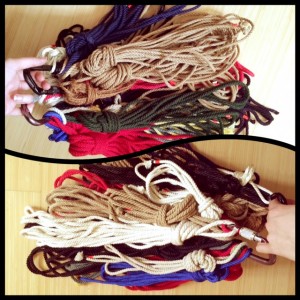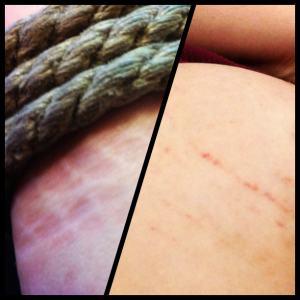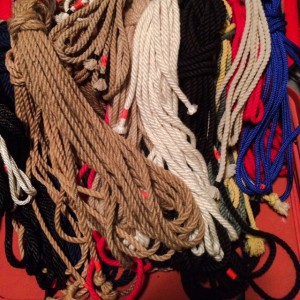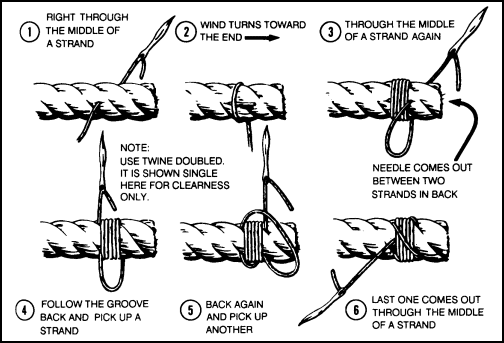Bondage rope is kinda like tacos. Sure the Taco Bell around the corner is cheap, convenient, and will do the job, but if you REALLY want tacos? Hunting down the elusive handmade street tacos are so totally worth it.
 So what makes a really good taco, and where can I find them? What ingredients should I be looking for in my taco? What is the best way to use my taco? What if I like spicy tacos and my partner doesn’t?
So what makes a really good taco, and where can I find them? What ingredients should I be looking for in my taco? What is the best way to use my taco? What if I like spicy tacos and my partner doesn’t?
OK so I’m not actually talking about tacos here, but the analogy illustrates a point— there are a lot of variables when it comes to bondage. What sort of accessories you use? How do you keep things safe? What happens when two tastes collide? Knowing what’s right for you can be hard.
Spending my days answering customer service questions for bondage rope company The Twisted Monk has given me a bit of insight into what questions folks are having trouble answering. This is why this guide exists. This is also why the second half of this guide is to be comprised of field-collected data and not my personal reviews. I know what I like (which might surprise you, but you’ll have to wait until the end for that), but rope is so variable and personal that there’s no way for any one person’s opinion to really lend much insight into rope selection and performance.
What is rope bondage?
Rope bondage can go by a lot of names: rigging, shibari, kinbaku, flying, hojōjutsu, and just plain ol’ bondage. There are many opinions about how to define the differences between all these things, if you like reading internet arguments go look up “shibari vs. kinbaku” and have yourself a blast. I personally don’t care what term you use for tying each other up for fun and profit ((Feel free to take that as you will)) as long as everyone involved knows what’s up.
I prefer to say rope bondage and use top/bottom or giving/receiving rope when talking about myself and to others. Call me a “rope bunny” and I swear to g-d I will find a way to climb through my computer and punch you in the face. To each their own, but the term feels needlessly diminutive, socially gendered, has a sense of vapidity, diminishes the role of someone receiving rope, and just rubs me wrong in a big way.
As I mentioned before about rope bondage names, there is plenty of discourse on the subject of the “origin” and “tradition” of rope bondage (mostly centring around Japan) which is fine and dandy and doesn’t particularly have any consequence to me. The idea that one nation’s feudal era owns the act of tying each other up for fucking is, to me, absurd. I don’t really want to get into it, and if I did it would become such a long clustermess of a post that no one would really want to read it. I sure as fuck don’t want to write it. So I’m not going to.
If you want to learn rope bondage techniques I STRONGLY recommend taking classes in-person. FetLife can be a good way to find local rope enthusiast groups in your area, as are groups like Rope Bite, and Hitchin’ Bitches International. You can’t go wrong with workshops by Lee Harrington or Midori. KinkAcademy has some really great videos.
There are also a number of really good books you can read and learn from: Shibari You Can Use and its sequel More Shibari You Can Use, Bondage For Sex [Note: As of early 2016, this title is out of print. Grab a copy while you can!], The Seductive Art of Japanese Bondage, Two Knotty Boys: Showing You The Ropes and its sequel Two Knotty Boys: Back On The Ropes.
A note about suspensions:
I strongly dislike the notion (that I find to be rather pervasive amongst the rope-interested) that suspension bondage is the end goal of tying each other up. Uhm, no. Wrong. Incorrect.
This is like saying that the end goal of sex is inherently orgasms, or that not having penis-in-vagina sex means you aren’t having real sex. Midori has been quoted saying “if you can’t make them fly on the ground, you have no business putting them in the air” and I believe in this wholly. I also feel like the objectification of suspension bondage as the ultimate endeavour can cheat you out of having a lot of fun on the ground/bed/chair/whatever.
Don’t ask me which of these ropes are “suspension grade.” I didn’t research for that. If you’re doing rope suspensions or want to do them but you don’t know which of these fibers are safe to hang someone’s wellbeing and life from the ceiling, please stop now and go get educated from another actual live person, not the internet.
What about rope bondage and safety?
 Bondage of any sort is risky business.
Bondage of any sort is risky business.
Always ensure you are engaging in bondage activities with another person. Yes, I know that self-bondage is something that many people enjoy, but I cannot in good conscience endorse such practices. Please, if you are considering self-bondage, read Jay Wiseman’s essay on the very real risks of self-bondage.
Have clear lines of communication between those giving and receiving rope before, during, and after. This is more than just safewords ((Or safe signs, or other means of communicating between individuals when something needs to change or be addressed. Remember that binding hands is, for a deaf person, equivalent to a ball-gag. Noise-cancelling headphones are much the same to a blind person. Consider who you are engaging with))— physical and emotional status should be open and on the table before you get started.
Working knowledge of the difference between good pain and bad pain is a pre-requisite. Make sure you have an easy and safe means of speedy release on hand in case of emergency– more than one is handy. I like safety/EMT shears and I have many of them. Please cut your rope if you have to, even if it was expensive ((Ropemakers generally understand that their products are expensive, and some of them will work with you to replace rope that was destroyed due to an emergency)). The life of another person is worth it. People can, and have, been damaged doing rope bondage. This is why education is important, and why I feel that rushing towards suspension is incredibly (and needlessly) risky.
ROPE IS REPLACEABLE. PEOPLE ARE NOT.
Is [type of rope] comfortable? I don’t want my rope to be painful/itchy/scratchy. Can I make my rope softer?
This is where I say that comfort is subjective, right? Yes— some rope is more stereotypically comfortable. There’s rope that is soft and supple as fancy lingerie, and there is rope that is rough and unforgiving as trying to fuck a cactus. Most natural fibre ropes soften with use and with age— a process which can be sped up on more robust fibres like hemp or linen by running them through a tumble dryer on air-fluff, or on more delicate fibres such as jute simply by working them through your hands for a while. Remember that as ropes age, either naturally or by mechanically accelerated means, they weaken.
What about rope burn?
Rope burn is typically not a concern with bondage, mostly because rope burn is a friction burn caused by the rope being pulled very quickly across the skin. In most cases, unless you are aiming for this effect, you don’t pull rope across skin fast enough to cause actual friction burns during rope bondage activities.
Many times, when someone is asking about rope burn they are actually referring either to compression rope marks or petechiae.
 Skin is soft and squishy, so when it’s bound or pressed on for a while it gets compression marks. Remember riding in the shopping cart as a kid and getting waffle butt? Or how sitting on the grass at a picnic gives you weird grassmarks on your thighs? These are compression marks. They go away after a short period of time and will most certainly be gone by tomorrow. Rubbing them doesn’t really do much, but hydration helps!
Skin is soft and squishy, so when it’s bound or pressed on for a while it gets compression marks. Remember riding in the shopping cart as a kid and getting waffle butt? Or how sitting on the grass at a picnic gives you weird grassmarks on your thighs? These are compression marks. They go away after a short period of time and will most certainly be gone by tomorrow. Rubbing them doesn’t really do much, but hydration helps!
Petechiae are caused by the pressure of blood trapped in capillaries of the skin (basically tiny bruises). This pressure can be caused by such simple things as bouts of coughing, crying, or vomiting (you may have noticed the little red freckle-like petechiae around your eyes last time you had the flu). In rope bondage they are teeny tiny lines of bruises which happen along the spaces between the ropes. Petechiae most commonly occur in particularly fleshy areas that require a lot of compression for ties to hold— breast bondage being the number one here, but thighs and butts can do it too. It’s much more rare on wrists or ankles except on larger softer bodies. They’re typically small enough to heal fairly quickly compared to a proper large bruise, and some folks believe that homeopathic remedies like Arnica montana can help speed the healing along. Your mileage may vary there.
What lengths of rope do I need? How much rope do I need?
The right length of rope is the one you have in your hand. Yes— if you’re looking at doing fancy rope corsets or full-body harnesses longer ropes are helpful. Most of the time, if you’re getting ready to have a sexy fun time with your sexy fun friend the last thing you want to be doing is rummaging around trying to find where the perfect length of rope is. Rope too long? Tie something else up! Rope too short? Tie another rope in! It may seem simplistic and possibly a little out-of-line from the posted rope requirements for bondage classes, but in practical application it has held true every time for myself and nearly all of the experienced rope bondage folks I’ve talked to throughout this project.
 What’s with the whole end finishing business?
What’s with the whole end finishing business?
Rope is probably one of the oldest tools around. People have needed to attach and bundle things to each other since the dawn of time, and at its most basic you don’t really need any special tools to make rope. The problem with rope is that it has two terminal ends where the fibres which have been spun together rapidly want to un-spin themselves. Something has to be done about this, or you quickly won’t have rope anymore.
The simplest method of solving this problem is just to tie a knot at the end. It’s not perfect, knots can (and do) un-do over time and under pressure, and they’re kinda bulky. People have developed methods of knotting that add less bulk to the rope, which are stronger and less prone to untying themselves, and which are lovely and decorative. The big problem with knots is that they get stuck. Notice I didn’t say they can get stuck. They will. Go tie some knots in the ends of your shoelaces and spend the next month tying and untying your shoes with those in place. The first time you pull the wrong end, or your laces get a bit snarled, you’ll see what I mean.
Knotted ends mean that when you’re tying for rope bondage, every time you reach the end of a rope as you pull through knots, those ends can stick. This feels jarring and weird, losing the fluidity of the rope. This also means when you need to UN-tie your rope, especially in an emergent situation, those knots can jam in a bad way. It’s happened to very experienced rope folk, and it can happen to anyone. This is why, to me, knots aren’t a wise or safe option. They may be more “traditional” but tradition doesn’t always mean safe. Sure, traditionally mountaineering was done with hemp ropes but unless you want to become a tragic story of failed man vs. nature, nowadays we use specialised climbing rope.
So if you’re not knotting your rope ends, what else can you do? Sailors have come up with a variety of solutions from taping (which works but isn’t a long-term solution), to dipping (again, it works but it’s not very pretty and the feel is weird), to what most sailors worth their salt do: whipping. There are a lot of ways to whip rope ends, none of which are particularly right or wrong. Whipped ends don’t add to the diameter of the rope, so they pull through cleanly and smoothly without jamming. One of the really handy features of whipping is that it can be done in a variety of colours, allowing you to colour code your ropes based on length, or partner, or age, or whatever. You can whip your own ropes, or most ropemakers are able to whip your ropes for you.
What is bondage rope made of?
You can find rope in all manner of materials. For this guide I compiled a selection of hemp, jute, linen, cotton, bamboo, silk, synthetic, and couple specialty ropes. They all have their pros and cons, and people like them (or dislike them) for a wide variety of reasons. Again “tradition” says jute or hemp rope (there’s much contention over this as well, just like anything where “tradition” comes into play). But in the end…
What is the best rope?
There is really only one rope which should not be in your bedroom, dungeon, or what-have-you, and that is the rope you do not use. Yup. That’s it. Are some ropes safer than others in certain applications, or do some ropes require more attention and know-how? Totally. But there is no right or wrong rope when it all comes down to it. The rope that is best is the rope that you (and your rope using compatriot(s)) enjoy. But you don’t have to take my word for it. *da-ding ding*
All of that out of the way, stay tuned for the second part of the Epic Bondage Rope Guide: Rope Comparisons! Part two is coming real soon, with research on over 25 different ropes across eleven different rope-makers and a multitude of rope-minded folks! Best in class, best of breed, and best in show all still to come!






Ooh, jealous! I really wanted to be into rope bondage. I spent a decent chunk of change on hemp rope, bought the Knotty Boys’ and Race Bannon’s books, tried to watch videos, even asked a rigger friend of mine if I could hire him to teach me. I…just…don’t think I’m obsessed enough, and I get OBSESSED when I like something. I’m sticking with chains and spreader bars, cuffs, and very basic rope stuff. I don’t think I’ll ever get to the point where I want to immerse myself enough in it to get good. That said, it makes me admire people who do it well that much more. Oh, and “rope bunny” always rubbed me the wrong way, too (no pun intended). How about “rope lioness” or “rope wolf”? LOL.
P.S. I like your blog, I’m excited to check out more of it!